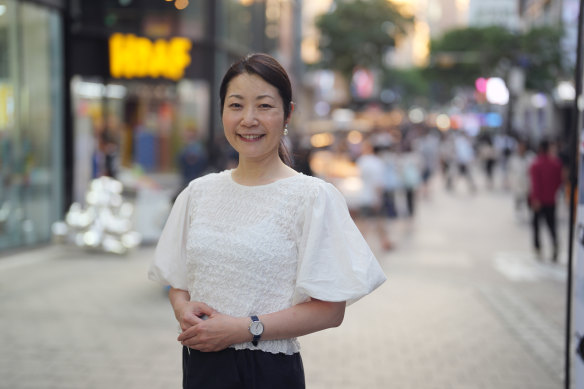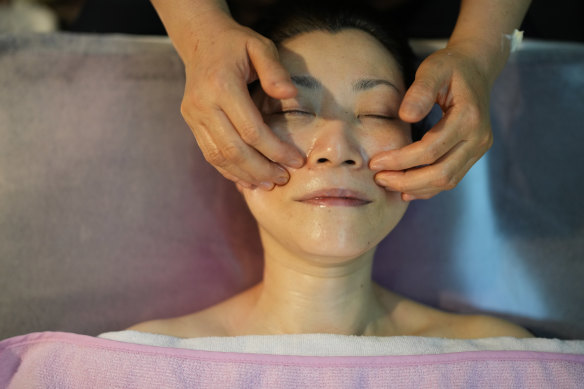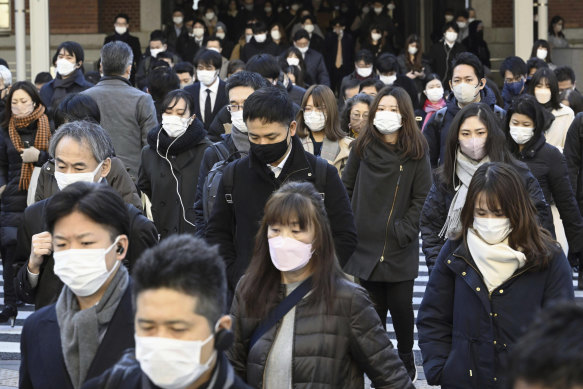Save articles for later
Add articles to your saved list and come back to them any time.
Tokyo: About six years ago, Keiko Kawano, a radio host, found that when she stopped doing voice-articulation exercises, her smile began to fade. At a certain point, she struggled to lift the corners of her mouth.
So Kawano, then 43, decided to learn how facial muscles work. After using the knowledge to reanimate her smile, she started helping others do the same under the motto, “More smile, more happiness”.
Japanese smile coach Keiko Kawano in Seoul last week.Credit: Chang W. Lee/The New York Times
And as many people in Japan unmask after three years and find their facial expressions a bit rusty, she is adapting her work to the post-COVID era.
“People have not been raising their cheeks under a mask or trying to smile much,” Kawano said last week, a few days after Japan downgraded COVID-19 to the same status as common illnesses. “Now, they’re at a loss.”
Kawano began teaching smiling at a gym in 2017 while working as a business etiquette trainer.
Despite having no medical training, her curriculum, typically taught in one-hour sessions online or in person, draws on yoga and emphasises strengthening the zygomatic muscles, which pull the corners of the mouth. She also believes that the muscles just below the eyes are key and that weak ones create eyebrow-driven smiles, which can make the forehead look wrinkly.
“People train their body muscles, but not their faces,” she said.
After her gig at the gym, she began teaching smiling at nursing homes and corporate offices, as well as to individuals hoping that a better smile might help to land better jobs or improve marriage prospects. One early client was IBM Japan, where she held a smiling-training session for company employees and their families.
Then the pandemic hit, hurting her business by hiding everyone’s smiles behind face masks. Still, Kawano was occasionally asked for advice on smiling through them.
Mask wearing was not legally enforced in Japan during the pandemic, but it became ubiquitous anyway, in part because Japanese people have been masking for decades as protection against allergies or pollution, or as a courtesy to protect others from illness.
Keiko Kawano receives a specific kind of facial in Seoul, South Korea, that she says will benefit her smiling muscles.Credit: Chang W. Lee/The New York Times
Kawano told her clients that the key to a masked smile was lifting the eye muscles. A TV presenter demonstrated her method on a national broadcast, she said, and a post about it online helped to raise her profile.
But the biggest spike in demand for her services came in February, she said, when the government announced that official masking recommendations would be significantly loosened.
“People started realising that they hadn’t used their cheek or mouth muscles very much,” Kawano said, speaking by phone while on a trip to South Korea, where she had an appointment for a facial that she said would be good for her cheekbones. “And you can’t just suddenly start using these muscles. You need to work on them.”
Yael Hanein, an expert on facial expressions, said she was not aware of any academic studies documenting the effects of long-term masking on facial muscles.
“Facial muscles can be trained like other muscles, although such training could be challenging, owing to large variability between individuals,” said Hanein, who runs a neuro-engineering lab at Tel Aviv University in Israel.
“A possible problem with a practised or faked smile is that it may be identified as such by other people,” she added.
There have been other smile-training classes in modern Japan, usually for retail employees. But in a Japanese social context, smiling is far less important than bowing. Some Japanese women are also acculturated to cover their mouths when eating or laughing.
“Smiling lessons seem very Western,” said Tomohisa Sumida, a visiting researcher at Keio University who has studied the history of masking in Japan.
Commuters wear masks outside Tokyo Station in January before COVID rules were downgraded.Credit: Kyodo News/AP
But Kawano’s clients appear to be happy with her work.
Miki Okamoto, a spokesperson for IBM Japan, said that Kawano’s smile-training session was “received well”.
In Kanagawa prefecture, south of Tokyo, about 40 seniors attended a 90-minute session with Kawano in October, and many found that it improved their smiles, said Katsuyo Iwahashi, a town official who works on public health programs. Iwahashi added that the town planned to offer a similar session specifically for mothers with young children “in the hope of helping them to smile despite the hardships that they experience” in motherhood and following the pandemic.
Kawano also holds a one-day certification training for people who want to teach smiling for 80,000 yen ($880), plus consumption tax.
One of her proteges, Rieko Mae, 61, now tells her own clients that smile practice is important even for people who smile a lot naturally.
“Sometimes, you need to show a nice, professional smile, and people don’t know much about that,” said Mae, who lives in Osaka and travelled to Tokyo for the course.
A smile-training course could help people improve their facial expressions and even build self-confidence, said Masami Yamaguchi, a psychologist at Chuo University who has studied how babies look at the facial expressions of their mothers.
“Intentional muscle moves will send signals to your brain and generate positive feelings, even if you are not feeling happy,” she said.
This article originally appeared in The New York Times.
Fascinating answers to perplexing questions delivered to your inbox every week. Sign up to get our Explainer newsletter here.
Most Viewed in World
From our partners
Source: Read Full Article



